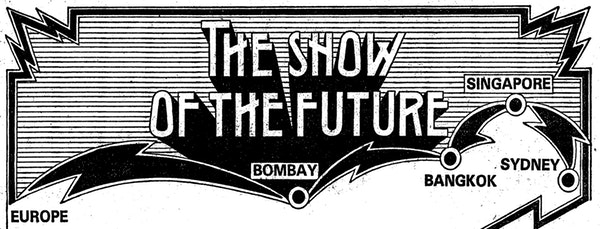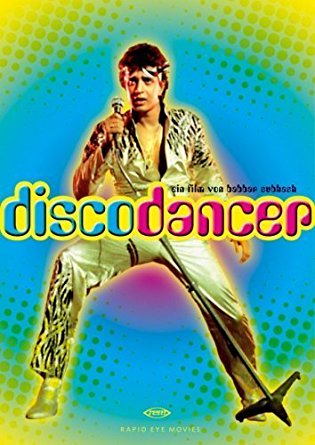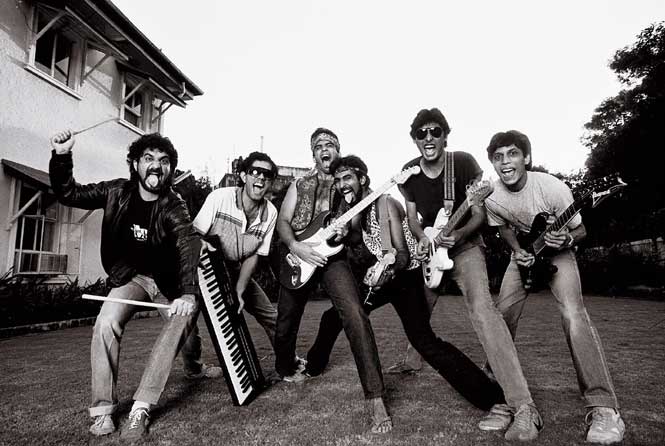The Alternative Music movement since its inception in the late 80s has reached out to every corner of the world today and of late, the Indian indie music scene has been it’s best and most diverse in years. Many of the early 60s classic rock legends such as The Beatles, The Rolling Stones, The Yardbirds and The Byrds were heavily influenced by Indian Classical music as a method of reinforcing psychedelia in their music. Rock music had not yet entered the realm of popular music in India until the mid-90s as much of the 80s music was Bollywood Pop Music infused with disco. A parallel can be drawn to the new wave synth-pop music of the 80s in the west with the Bollywood disco of India. Just as Raga Rock gave rise to the forever evolving psychedelic sounds of experimental rock bands of today, the new wave help shape one of most memorable times in pop music of the subcontinent in the 80s – a time when disco, a seemingly foreign genre reigned supreme with the likes of Pakistani Pop singer Nazia Hassan, Indian artists such as Usha Uthup, Bappi Lahiri and none other than Mithun Da, the poster boy of Disco in India. Because of Bollywood’s surreal collisions of influences and preponderance of vocals, songs were rarely as techno as they could have been, but they seemed to be directing towards electronic music in the future which at that time, was a far-fetched imagination. In 1981, German Electronic and techno music greats Kraftwerk performed in Bombay for their Computer World Tour which involved a concoction of eastern and American sounds triggering a strikingly original musical intent amongst amateur artists growing up in the Indian music scene in the 80s.

Poster for Kraftwerk’s Computer World, Asia Tour.

Mithun Da.
Just as disco fizzled out, and MTV arrived, tastes rapidly changed and bands were encouraged to incorporate more hardened and underground styles of thrash and alternative metal. Rock Machine, later to be known as Indus Creed came into being, are still one of the most popular rock bands from India. A lot of bands converged the popular Britpop sound with post grunge, ancient Indian classical tunes and folk music with Raga rock which led to the emergence of Fusion rock which is often synonymous with Indian rock worldwide.

Indus Creed
The 2000s saw the rise of individual singers and boyish indi-pop(Indian Pop) bands such as Palash Sen’s Euphoria, Silk Route, Lucky Ali, KK amongst many others which were accepted by the Bollywood industry and marketed as Indian pop musicians. Simultaneously, hard rock and metal scenes were being set up from ground up with an anti-pop mentality in major cities of India with its similar but varied rock n roll expression in the English language as well as many regional Indian languages. Bangalore being a new age rock/metal capital of India housed experimental bands like The Raghu Dixit Project, Kryptos, Swarthama. Bangalore also has been a popular destination for international rock and metal acts such as Opeth, Iron Maiden, The Rolling Stones, Bryan Adams, Scorpions, Sting, Aerosmith, Elton John, Deep Purple, Metallica, Slayer and Megadeth. Delhi had Parikrama, Menwhopause and Indian Ocean while Motherjane and Thaikuddum Bridge of Kerala represented Malayali rock. Kolkata, an eastern city of India, has a rich regional rock scene ie Bengali rock spearheaded by Fossils, Cactus and Moheener Ghoraghuli. Mumbai, the city of Bollywood is also the birthplace of homegrown hard rock and metal acts such as Bhayanak Maut and Pentagram. For the longest time, the alternative scene in India only consisted of heavy metal and hard rock and largely influenced by the manic and hard-core rock period of the late 80s and it continued in similar directions till the 2010s when indie music started to sober down and become very avant-garde influenced by 90s alternative rock, 2000s garage rock revival and dance-punk. Electronica also made its way with talented artists like Sahej Bakshi aka Dualist Inquiry, a Delhi based producer, composer and multi-instrumentalist, is one of my favourites in the indie scene of India, today. His music is indietronica at heart, but absolutely genre-defying with guitar driven sounds and an eastern rhythm and beats which stand out from the ever-growing pervasiveness of commercial electronic music. On the other equally creative side of Indian Indietronica is Nucleya. Udyan Sagar aka Nucleya is one of the most skilful of musical artists from India, without a doubt. His music comes from the busy and festive streets of India with its complementing but wildly diverse cultures. Udyan Sagar has revamped the indie scene bringing in the attention of Bollywood as well mainstream music fans with his hyped up Indi-dubstep music with ponderous bass drops. He has performed at numerous music festivals around the world including Glastonbury, Edinburgh Fringe Festival, Lille 3000 and the Electron Festival, where he performed alongside artists like Diplo and Modeselektor. In terms of their approach to electronica, Dualist Inquiry and Nucleya are on two opposite sides of the plane but share youthful camaraderie as musicians and pioneers of new age electronica in India. Personally, I would be thrilled upon a collaboration between them as of how I see it, it would push Indian electronica to the next level. Other notable artists of this sphere of music from the Indian Subcontinent includes Sandunes, Sid Vashi and Madboy.
Shaair n Func composed of Monica Dogra and Randolph Correia, formed in 2007 were the pioneers of alternative electro-pop and dance music in India and were the first of their kind but of late, there have been many distinguishing and unique dance-punk bands and the most successful of the lot has been The F16s and Ganesh Talkies. Chennai/Bangalore-based Dance-Punk band The F16s have a penchant for the weird. After experiencing them live on a Red Bull Tour Bus event in college, I was convinced that band like The F16s had not existed in India before. They performed songs from their Kaleidoscope EP live and had my mind blown as I heard their groovy introspective tunes merged with a punk rock delivery. Kaleidoscope proves how a band can use electronica to win over both bass-heads and rock fans. On the same page as bands like The Arctic Monkeys, The Strokes and Vampire Weekend, The F16s also drive into the dance floor with electronica influences ranging from trip hop to dubstep. At their live gigs, they follow American electro-alt rock band Mutemath’s lead and switch instruments around for a noisy closing jam, all drums beating and guitars on overdrive. Their very first album Triggerpunkte was released August of 2016 and as I heard it, it felt nothing less than alternative music gift to the scene today. Employing noisy blues and amped up dance punk sounds is inspired by the constant struggle against the triviality of mainstream music today. The album mastered in the famous Abbey Road Studios, they have finally begun making it in the music business and also making an indelible mark in alternative music of India. On the other hand, we have Ganesh Talkies from Kolkata is everything the F16s are not. They for one, embrace the corny Bollywood pop culture and maximize it with a quirky combination punk rock and disco, making them probably, the only noteworthy Bolly-Punk band in India. They have been self-described as a keora/changra-rock. (keora or changra is a Bengali slang term describing the out of control youth in Kolkata who are probably into rock music and marijuana smoking, which is basically Punk Rock). Their only album so far, In Technicolor includes upbeat anthem-like dance rock songs with an obvious Bollywood undertone, making the record one of the most creative by any Indian band in the circuit in years. Since Ganesh Talkies’ Bollywood Punk music and The F16s electro dance pop music is an unfamiliar genre to put into words, you should go ahead, give them a listen and let their music speak for themselves, which it most certainly will.
Album Covers of Triggerpumkte by The F16s and In Technicolor by Ganesh Talkies.
Essentials Tracks by The F16s: Lightbulb, Blackboard and Jacuzzi from Kaleidoscope EP and Moon Child and Cannibal Life II from TriggerPunkte.
Essential Tracks by Ganesh Talkies: Item Song, Dancing! Dancing! And Fight Club from In Technicolor
Speaking of Indian Indie, the dream pop duo of Nischay Parekh (vocals, guitar, synths) and Jivraj Singh (drums, electronics), come together to form Parekh and Singh. Experimental pop has not been a defining genre in India but this duo is breaking boundaries with their soft, dreamy and minimalistic electronic pop music. Rolling Stone India named Ocean, their first album one of the best albums of 2013 which the duo released independently. The band re-released Ocean in October 2016 on Peacefrog, a British indie label. Parekh & Singh then re-released the single I Love You Baby, I Love You Doll. Its music video, which was shot on a US$5000 (INR₹322324) budget, features an aesthetic influenced by the American film director Wes Anderson. It has since garnered over 900,000 views on YouTube, considered to be a significant feat for an Indian indie band. They have had an album tour in the UK and have only begun charting worldwide success.
Other Indian Indie musicians and bands that have stayed true to the alt-force including brilliant riffage rock likes of The White Stripes and Franz Ferdinand to a solo modern jazz and blues act to India’s very own and very peculiar psychedelic rock to alternative Hindi rap and hip hop to several mind enticing eastern electronica:
#1
Skrat – Stomp
#2
Deep Phoenix – Travel Song
#3
Sky Rabbit – Hilltop
#4
Naezy – Asal Hustle
#5
Sid Vashi – Darling
#6
Nicholson – For What II
#7
Sandunes ft. Nicholson – Slybounce
#8
MadBoy – Mayonnaise
#9
Peter Cat Recording Co. – Love Demons
Culturally, for a certain type of music to prosper it is necessary for a scene of conscientious musicians to stay true to their DIY ethics which should be well supported by the niche audience and organisers in pockets of every major city in the country. For a nation which is obsessed with over produced Bollywood party numbers, an alternative music movement will not be welcomed with open arms as people tend to criticise what they do not understand. But, as long as good music is being made by authentic artists, a dominant indie music scene in India will gather numbers and will change how people from here and everywhere perceive Indian music as and that is the dream.



Thanks for continuously posting. I really like your posts and believe that they contribute a lot of actual worth. I came across this Spotify playlist recently and think it suits posts that you’ve uploaded. http://spoti.fi/2v7a0MA really hope all of us listen to it!
LikeLiked by 1 person
Woah, That was really well written and very intersting,
LikeLiked by 1 person
Reblogged this on The culture club and commented:
I wasn’t sure what to post leading up to holiday ramblings tonight, but I found this great piece on TheIndianIndieHead that I highly recommend you go check out. Here it is.
LikeLiked by 1 person
Appreciated! Thanks for the support!
LikeLiked by 1 person
You’re welcome!
LikeLike